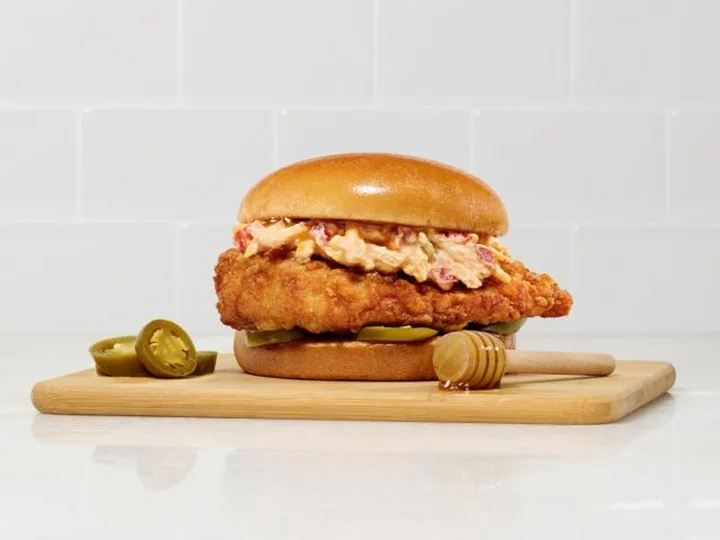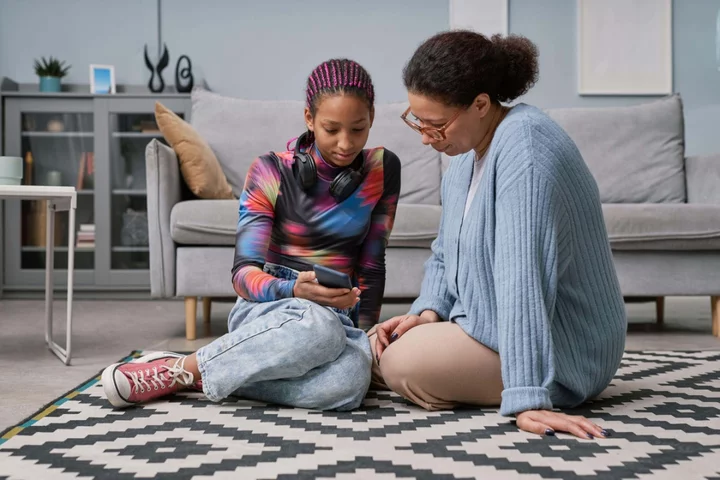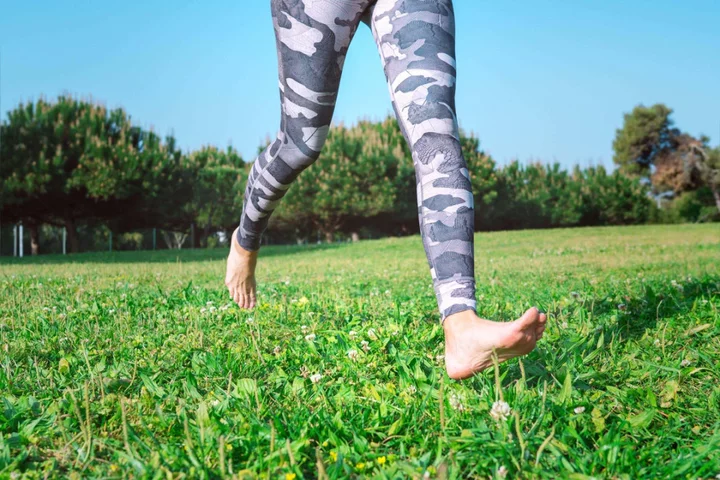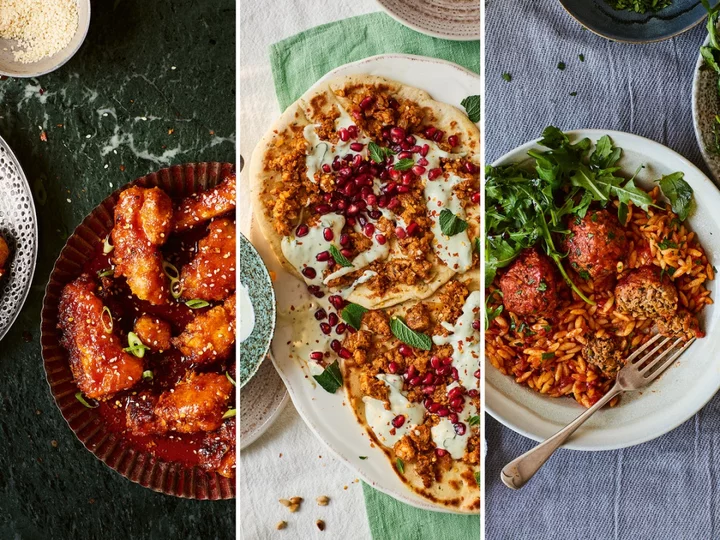
Chicken sandwich wars revived by new creative offerings at the nation's largest chains
Chick-fil-A's first foray into the chicken sandwich wars was so successful that it's launching a second entry, marking the first time the chain has altered its well-known fried chicken sandwich.
2023-08-18 23:50

Socialize, exercise and eat your vegetables: The Mediterranean lifestyle helping people live longer
Scientists have found more evidence to suggest that leading a Mediterranean lifestyle could be key to living a longer and healthier life. People who follow a Med lifestyle – including making time for socialising; resting; physical activity and eating a diet rich in fruits, vegetables, and whole grains with low sugar and salt intake – are less likely to die prematurely or die from cancer. And those who get plenty of rest, exercise and make time to socialise with friends are less likely to die as a result of a heart attack or stroke. The new study examined data on 110,799 adults taking part in the UK Biobank study. People aged 45 to 70 from England, Wales and Scotland provided detailed information about their diet and lifestyle habits. The researchers, led by academics from La Universidad Autonoma de Madrid in Spain and Harvard TH Chan School of Public Health in the US, examined information ON Mediterranean food consumption; Mediterranean dietary habits – such as limiting salt and consuming healthy drinks – and lifestyle habits including taking regular naps, exercising, and spending time with friends. Higher total scores in these categories indicated a higher adherence to the Mediterranean lifestyle, the authors said. People involved in the study were tracked for nine years. Some 4,247 people died including 2,401 from cancer and 731 from cardiovascular disease, which includes heart attacks and strokes. Researchers found that people who followed a Mediterranean lifestyle were 29% less likely to die compared to their peers who did not follow this lifestyle. They were also 28% less likely to die from cancer, according to the study, which has been published in the journal Mayo Clinic Proceedings. And people who got plenty of rest and exercise, while also making time to socialise with friends, were also less likely to die from cardiovascular disease. “This study suggests that it’s possible for non-Mediterranean populations to adopt the Mediterranean diet using locally available products and to adopt the overall Mediterranean lifestyle within their own cultural contexts,” said lead author Mercedes Sotos Prieto, from La Universidad Autonoma de Madrid and Harvard Chan School. “We’re seeing the transferability of the lifestyle and its positive effects on health.” Read More Meghan’s got one. Gwynnie, too. But should YOU get a stress-busting wrist patch? How parents can support their children on GCSE and A-level results day A-Level results: How to be the emotional support your teen really needs
2023-08-18 23:47

Influencer Caleb Coffee hospitalised after falling off cliff in Hawaii
Influencer Caleb Coffee has been hospitalised after falling off a cliff during a hike in Hawaii, according to a GoFundMe page created by his sister. On Thursday 17 August, Coffee’s sister Peyton created the page, where she revealed that her brother is in the intensive care unit with a spinal fracture and broken femur, elbow and wrist. His sister also states that they don’t know the “extent” of his injuries yet, but that they also include “multiple gouges and burns throughout his entire body” According to the GoFundMe, Coffee was hiking with three friends when he “slipped and fell off a 60-80ft cliff onto lava rock”. He was reportedly airlifted to a nearby hospital, with Peyton telling fans that her brother “hasn’t been able to hold down food”. “The medics have informed us more injuries will most likely pop up over the next few weeks…” she added. As of Friday, the GoFundMe has raised $16,000 of its $100,000 goal. Coffee, who has more than 11 million followers on TikTok, updated his followers with a video posted to the platform on Thursday, where he wrote that it’s a “miracle” he’s alive. “Hey everybody, I just want to give a massive thank you to anyone that’s trying to help me or support me right now and I wanted to let you guys know a little update I just found out, that my neck and spine is not broken. Phew,” the TikToker said in the video, which he filmed from his hospital bed. More follows... Read More Schoolboy almost dies from swallowing magnets for TikTok challenge Woman shares honest review of New York City apartment TikTok mom slammed after making 5-year-old son run in 104 degree heat
2023-08-18 22:54

What is money muling and why is it vital parents warn their children about the dangers?
Teenagers often like to have the latest gadgets and trainers, but if a young person suddenly has the ability to splash cash around, with no obvious explanation for their wealth, it could be a warning sign of money muling. Money muling happens when people are persuaded to let cash flow through their bank account in exchange for money or gifts – and young people in particular may be targeted. According to figures released by UK Finance and the fraud prevention body Cifas, young people under the age of 21 account for around one in five cases where money muling activity is suspected. While money muling may be seen as an opportunity to make some easy cash, it’s actually a criminal offence. The cash flowing through bank accounts is often the proceeds from crime. UK Finance and Cifas run a campaign called Don’t Be Fooled, which has developed free PSHE (personal, social, health and economic education) resources for schools, to help young people learn about the dangers and consequences of becoming a money mule. The new schools programme is aimed at youngsters aged 10 to 14. To find out more about the dangers of money muling – and the warning signs for parents to look out for – I asked Paul Maskall, manager of fraud and cybercrime prevention at UK Finance, for his expert insights: How can parents talk to children and teenagers about money mule activity and explain what it is? Paul says: “Even at the best of times, we aren’t always good at valuing and protecting our data, personal information or private details which we store digitally.” He says it’s important for parents to explain what money mules are, “to ensure that the newer generation have a better understanding of how to protect themselves.” He continues: “By doing so, it gives them more of an intuitive defence and understanding of the risk of people wanting to exploit them and gain access to their account, for the purposes of laundering money.” How can young people themselves avoid getting involved in money muling? Maskall stresses the importance of keeping accounts and personal information private. He says: “Criminals seek to manipulate you with a promise of gifts, rewards or a percentage of the funds sent through your account.” People should avoid opening a bank account in their name for someone else, allowing their bank account to be used to send and receive funds for other people, or sharing PINs and passcodes, he says. While criminals will often seek out younger people to become money mules, it’s also important to remember that anyone can be targeted, he adds. What are the warning signs that your child could be involved? “Tell-tale signs that your child might be involved in money muling could be them suddenly having extra cash, buying expensive new clothes or top-of-the-range mobile phones and gadgets with very little explanation as to how they got the money,” Maskall explains. “They may also become more secretive, withdrawn or appear stressed sometimes, becoming more fixated on communication and phone usage.” What are the consequences of money mule activity? Some people may see requests to pass money through their account as harmless – but they could be making a big mistake. “Criminals need money mules to launder the profits of their crimes and frequently target young people, who are often unaware of the consequences of them agreeing to do so,” says Maskall. “Allowing a bank account to be used in this way is a crime and can result in a criminal record and the account being closed. “You could go to prison for up to 14 years and it can also lead to the individual finding it difficult to obtain mobile phone contracts or access financial products and credit, including student loans.” What should parents do if they think their child or someone else they know might be involved in money muling? “It’s important for parents and guardians to remind their children of the potential approaches that they may receive from criminals,” says Maskall. He says if any parents or guardians are worried that someone they are close to might be caught up in money muling, they can contact Crimestoppers anonymously on 0800 555 111. Where can parents go to get support or seek further information and how can communities stay safe? Maskall says: “We encourage everyone to visit the Don’t Be Fooled website for more information on the risk of money muling and how to stop the signs. www.moneymules.co.uk. “It is important to remember that anyone can be at risk and speaking openly and educating one another about the harm and risks involved will benefit others.” Read More From tofu chicken wings to chickpea bacon – how and why you should be making plant-based meat at home Holly Willoughby channels Gwyneth Paltrow with ‘orgasm anxiety’ blog post Do it for the Gram: Speedy but spectacular goat’s cheese linguine Charity boss speaks out over ‘traumatic’ encounter with royal aide Ukraine war’s heaviest fight rages in east - follow live
2023-08-18 20:23

Tempted to try barefoot running? Here’s what you need to know
Barefoot running seems to be rising in popularity, with fans hailing its many benefits – and some even tackling entire marathons without shoes. The thought of bare soles beating the pavement may leave many people wincing, and there are certainly things to consider before giving it a go. But the idea of exploring the most natural way to move – with our primitive bare feet on the ground – could be tempting too. So, what is the deal with barefoot running, and is it worth it? Are there any benefits to barefoot running? “Barefoot running really helps us reconnect with nature,” says Sammy Margo, a physiotherapist working with muscle and joint care specialists Deep Freeze and Deep Heat. For many, this is a big part of the appeal – and some fans of barefoot running say they’ve experienced benefits to their running form too. It’s important to remember our bodies may all respond differently to pressure and force, however, so how we react to barefoot running may vary. “The body, muscles, and joints will take on the ground pressure differently,” says podiatrist Dina Gohil, brand ambassador for CCS Foot Care. “Some people may experience improvement in pain in certain areas, and vice versa. The body works together and force is distributed to the best of your body’s ability to enable the movement you’re trying to achieve.” If you can physically feel your feet hitting the ground however, in theory, your body may become more aware of those forces and movement patterns. “Going shoe-free can help with your awareness of the position and movement of your body – proprioception. Exercising barefoot can also help restore natural running patterns and strides,” Gohil explains. For example, she adds: “Being barefoot can actually allow you to be more conscious of how the heel strikes on the ground, and at what pace and strength. So doing activities barefoot can help strengthen the foot and ankle, improve muscle strength, increase flexibility, and allow for proper movement.” Will you notice other changes? According to barefoot runners, the soles of your feet will also become a lot more resilient over time. “The best way to toughen feet is to try and walk on as many different surfaces as possible. Some people have also used newspapers on the ground to walk on to help with this process,” says Gohil. The muscles in your legs will develop differently too. Margo says: “Running barefoot also activates smaller muscles in our legs and feet, helping to improve strength and overall mobility.” Are there any risks or cons to think about? While many runners experience a range of benefits from going barefoot, there are certainly potential risks to consider. First and foremost, there’s the risk of wounding yourself if you stamp on something sharp – so always be sensible when choosing where to run barefoot. “Until your feet become acclimatised, you may find you are more prone to blisters until firmer skin or calluses have formed,” says Gohil. “There is also the increased risk of developing plantar fasciitis on the sole and heel of the foot. Other problems might include blisters, callus, cuts, infection, Achilles tendonitis, tight lower leg muscles, or stress fractures.” Margo adds: “As our muscles are working harder, [they] may become shorter and tighter, and you may feel some pain initially when you start barefoot running.” Having the support and comfort of a well-fitting running shoe can also be vital for many runners, particularly if you have a history of injuries or joint problems – so it’s advisable to speak with a healthcare professional before you attempt barefoot running. Read More Charity boss speaks out over ‘traumatic’ encounter with royal aide Ukraine war’s heaviest fight rages in east - follow live How can you get rid of acne scars? From serums to laser treatments, experts talk through the options 5 viral TikTok fake tanning tips for the perfect summer glow Not got the A-level grades you needed? Here’s how to get started with the clearing process
2023-08-18 15:53

From tofu chicken wings to chickpea bacon – how and why you should be making plant-based meat at home
Turns out you can still eat meat without the carbon footprint – just make it plant-based. That’s the ethos behind Henry Firth and Ian Theasby’s new book. The duo behind the best-selling BOSH! series have released (dun, dun, dun...) Meat, which shows you how to cook delicious dishes that feel and taste like meat, but are in fact 100 per cent plant-based. After “giving veganism a whirl” for a month in 2015 (“before it was cool,” they add) – partly prompted by a desire to improve their health and partly after watching the eye-opening environmental documentary Cowspiracy – the pair made the switch permanent and launched BOSH. The rest, they say, is history – and it’s certainly a successful one. But going cold turkey (ahem) wasn’t all smooth sailing. “Initially, the main thing we missed was choice,” Theasby tells The Independent. Back in 2015, when he walked into a restaurant or a supermarket, there simply wasn’t much on offer. “In Pret, you’d get a hummus wrap if you were lucky. If you went to Tesco, you might get a really dry, crumbly falafel sandwich and that was it,” he says. But, fast forward eight years, “you walk into a supermarket today and it’s not what can I eat, but what shall I eat? Because there’s so much choice.” Theasby and Firth are the first to admit that even enduring vegans get cravings sometimes. In their new book, they say: that’s okay! Plants can be meat too. “If you think about a burger, it can made from an animal or it can be made from a plant. We accept that now,” says Firth. It might be strange to hear a vegan say that “we should celebrate meat” but “it’s got wonderful flavours, wonderful textures, but you can make it from plants, either from using vegetables or using some of those products that are now everywhere in the supermarket, which are pretty damn good.” The keyword is texture, says Theasby. “One thing that people lack when they first start eating plant-based is texture, so what we wanted to do was produce a book that was packed full of bite and chew so your mouth doesn’t miss anything when you first go plant-based. Some of the recipes in there you would not be able to guess are plant-based.” The recipes in Meat use a combination of meat alternative products and straight-up plants to achieve this. For example, there’s a section at the start that details how difficult it was to recreate bacon. Using a mix of chickepas and seitan (also known as vital wheat gluten), with flavourings like miso and colourings like beetroot, they create a kind of red and white dough that is rolled out, kneaded and cut into the shape of a piece of bacon. “It looks like bacon, it has the same mouthfeel as bacon, it’s got the same flavour profile as bacon,” says Theasby. “It’s a magic thing.” Don’t let that put you off, says Firth. “People do get a bit freaked out and they’re scared of ultra-processed stuff and of what’s in it. It’s good to read the label but it’s also good to not be scared by new things just because they’re new.” If you aren’t freaked out, however, we’ve got three sneakpeak recipes from the new book to put your mind at ease. Crispy Korean-style ‘chicken’ wings “These wings are SO crispy and delicious! Seriously, we love them. You can eat them as they come or you could push the boat out and serve them in a sandwich with a little plant-based mayo, kimchi and lettuce with a side of fries. They’d also go well with a side of rice and a little salad. Whichever way you choose, we’re pretty sure you’ll love them as much as we do.” Serves: 4-6 as a side Ingredients: For the sticky marinade: 4 garlic cloves 2.5cm piece of fresh ginger 150g gochujang 120ml toasted sesame oil 2 tbsp rice vinegar 2 tbsp light soy sauce 4 tbsp light brown sugar ¼ tsp ground white pepper For the ‘chicken’: 2 x 280g blocks extra-firm tofu 6 tbsp cornflour ½ tsp sea salt ¼ tsp ground white pepper Vegetable oil, for shallow frying For the garnish: 1 fresh chilli or a pinch of dried chilli flakes 1 spring onion A few toasted sesame seeds, for sprinkling Equipment: Fine grater or microplane Blender (optional) Frying pan Saucepan Method: Line a plate or large bowl with kitchen paper Make the marinade: Peel the garlic and ginger and grate with a tine grater or microplane. Combine with the rest of the ingredients and either blitz in a blender or combine in a bowl and stir into a nice smooth paste Prepare the chicken: Press the tofu to remove excess liquid. Tear the tofu into rough chunks about 3 x 2cm. Add the tofu to a mixing bowl along with half the marinade and fold to coat. Sprinkle the cornflour, salt and pepper into the bowl and fold to coat and combine, making sure the tofu is really well covered. Cook the chicken: Pour 1cm of oil into a frying pan and heat over a medium-high heat until the oil bubbles around the end of a wooden spoon that’s held in the oil. Carefully lower the tofu chunks into the hot oil and cook for 2-3 minutes until golden and crispy, turning them regularly to ensure a really even cook. Remove carefully and drain on a plate lined with kitchen paper. Finish the dish: Put the remaining marinade into a saucepan, bring to a simmer and cook until thick and shiny. Add the cooked tofu to the sauce and quickly fold it through to ensure a good coverage. Spoon the tofu into a serving bowl. Trim and thinly slice the spring onion for the garnish and finely chop the chilli (if using fresh chilli). Garnish the tofu with the chilli or chilli flakes, spring onion and toasted sesame seeds and serve immediately with some cold beers! Lebanese-style ‘lamb’ flatbreads with minty yoghurt “Making flatbread may feel like a labour of love but, really, it involves just a handful of cupboard ingredients and a few kneads to create delicious flatbreads that are impossibly soft on the inside with a glorious golden crust on the outside. You could serve them with anything, but we’ve stacked them high with a crumbled tempeh lamb spiced with mint, lemon and chilli, and drizzled them with a zesty mint yoghurt. “This recipe is good for 2, so if you need to serve 4 simply double everything. Deeeeelicious!” Serves: 2 Ingredients: For the flatbreads: 140g strong white bread flour, plus extra for dusting 1 tsp fast-action dried yeast 1 tsp caster sugar 1 tsp baking powder 1 tsp dried mixed herbs 1 tsp table salt 80ml lukewarm water 1 tbsp olive oil Plant-based butter, softened, for brushing For the ‘lamb’ topping: 300g tempeh 1 onion 2 garlic cloves splash of olive oil 1 tsp ground cumin ½ tsp ground coriander ½ tsp ground nutmeg 1 tsp smoked paprika 1 tsp chilli powder 2 tbsp mint jelly 1 lemon Sea salt For the mint yoghurt: A few fresh mint leaves 150g plain plant-based yoghurt 1 tbsp mint jelly 1 lemon Sea salt To serve: Handful of fresh mint leaves Handful of pomegranate seeds 1 tbsp toasted pine nuts Pinch of dried chilli flakes Black pepper Equipment: Large saucepan 2 large flat pans (or 1, and cook the flatbreads in batches) Pastry brush Method: Make the flatbread dough: In a large bowl, mix together the dry ingredients (the flour, yeast, sugar, baking powder, mixed herbs and salt) until there are no lumps. Pour in the lukewarm water and olive oil and bring the mixture together to form a dough ball (ensuring you incorporate every part of the mixture). Place the dough ball on a lightly floured surface and knead for 6-10 minutes until the ball bounces back when pressed. Place the ball back in the bowl, cover and leave somewhere warm for at least 30 minutes Make the lamb topping: Crumble the tempeh into small pieces using your hands. Peel and dice the onion and garlic. Place a large saucepan over a medium heat and add the olive oil. Add the diced onion, garlic and a pinch of salt. Mix well and cook for 5-10 minutes until the onion begins to soften. At this point, add the spices and crumbled tempeh with a dash of water. Mix well and cook for 5 minutes, then stir through the mint jelly. Halve the lemon and squeeze in some lemon juice, catching any pips in your free hand. Reduce the heat to low and cook for 10 minutes Make the mint yoghurt: Thinly slice the mint leaves. Put the yoghurt in a small bowl and mix through the mint jelly, sliced mint leaves and a pinch of salt. Halve the lemon and squeeze in some juice, catching any pips in your free hand. Spoon into a small serving bowl Cook the flatbread: Place 2 large flat pans over a medium heat (over separate flames). Take the flatbread mixture from the bowl and halve it. Place each piece on a lightly floured work surface and push down using your hands or a rolling pin to create a round, flatbread shape – it should be quite thin as it will become thicker in the pan. Once the pans are hot, add the flatbreads and cook for 2-3 minutes on each side until golden all over and cooked through. If you don’t have two flat pans, cook the flatbreads in one flat pan, one at a time. Assemble the flatbreads: Place the flatbreads on 2 serving plates and brush with some butter. Spoon the lamb mixture on top of the flatbreads then drizzle over some mint yoghurt. Time to serve: Chop some mint leaves and sprinkle them over the top of the flatbreads, along with a pinch of black pepper, the pomegranate seeds, pine nuts and chilli flakes (or your favourite toppings) Orzo ‘meat’-balls “Orzo – a type of pasta – is an ingredient we don’t use very often but when we do use it, we’re always left wondering why we don’t use it more often because it’s lovely. On the subject of lovely, the inspiration for this magnificent recipe came from the queen of cooking herself, Nigella Lawson.” Serves: 4 Ingredients: For the meatballs: 20g flat-leaf parsley (including the stalks) 3 garlic cloves 2 tbsp chia seeds 600g plant-based mince 3 tbsp panko breadcrumbs 4 tbsp nooch (nutritional yeast) or grated plantbased parmesan 2 tsp sea salt 2 tsp ground black pepper For the sauce: 1 small onion 20ml olive oil 1 tsp sea salt flakes 250ml plant-based white wine 2 x 400g tins chopped tomatoes 3 tbsp tomato puree 1 tsp paprika ½ tsp dried chilli flakes 1 tbsp red wine vinegar 1 tbsp light brown sugar 2 tbsp plant-based butter 285ml cold water 250g orzo pasta To serve: Handful of fresh parsley Sprinkle of nooch (nutritional yeast) or plant-based parmesan Small bag of fresh rocket Squeeze of lemon juice Equipment: Large heavy-based saucepan with lid Make the meatball mixture Finely chop the parsley and set aside Peel and finely chop the garlic Soak the chi a seeds in a bowl with 4 tablespoons of cold water for about 10 minutes until it forms a gel Ingredients: Place all the ingredients for the meatballs into a large bowl and mix together with your hands, being sure not to overmix, as it will make the meatballs dense-textured and heavy. Make the meatballs: Pinch out pieces of the mix and form them into walnutsize balls, putting them on a clean plate as you go. You should get about 20 meatballs. Make the sauce: Peel and finely dice the onion. Heat the oil in a heavybased saucepan that’s large enough to take the meatballs and pasta. Add the chopped onion with the salt and cook over a medium heat, stirring every now and again, for about 10 minutes until softened. Add the wine and simmer for a further 10 minutes. Add the tomatoes, tomato puree, paprika, chilli flakes, vinegar, brown sugar and butter. Fill both the empty tins with the water, give them a good swill, pour into the pan, bring the sauce to a simmer, put the lid on and cook for 30-35 minutes. Cook the meatballs: Drop the meatballs gently into the simmering sauce. Bring back to the boil, turn the heat down again to a simmer, put the lid back on and simmer the meatballs for 15 minutes. Add the pasta: Tip in the orzo, stir gently and increase the heat to bring the mixture back to a bubble. Simmer for 15 minutes, or until the pasta is cooked. You will have to stir it occasionally throughout this time to make sure the orzo isn’t sticking to the bottom of the pan. Time to serve: Chop the parsley (to serve). Spoon the pasta into bowls, sprinkle with parsley, nooch and a handful of rocket, add a squeeze of lemon juice and tuck in. ‘BOSH! MEAT’ by Henry Firth and Ian Theasby (HQ, HarperCollins). Read More The dish that defines me: Mallini Kannan’s baked honey-soy salmon Breakfast for dinner and four other things you should cook this week How to save money in the kitchen according to top chefs Money-saving chilli con carne that absolutely slaps with flavour How to pimp up your instant ramen (and save money) Do it for the Gram: Speedy but spectacular goat’s cheese linguine
2023-08-17 22:20

Gotthard: World's longest rail tunnel shut for months after freight crash
National Swiss rail operator SBB said a derailed freight train caused severe damage to tracks.
2023-08-17 18:26

What can you actually do to help prevent cancer, as 12% believe coffee is carcinogenic?
A new poll has found that 12% of people still believe that drinking coffee is carcinogenic. The new poll – conducted by the World Cancer Research Fund (WCRF), which surveyed 2,092 adults via YouGov – looked into the different ways people live, and whether it impacts their risk of cancer. The research found that 86% of people believed smoking increased the risk of cancer, while 60% said that being overweight could do the same. 47% thought being physically inactive can be detrimental, and 59% believed a poor diet can up the odds. Almost 59% said alcohol can increase a person’s risk and 55% said processed meat could be a risk factor. WCRF launched its poll to highlight its free eight-week interactive programme Activ8, to provide people with tips on making healthier food and drink choices, and finding different ways to be more active. Cancer Research UK wrote on their website that “not all cancers can be prevented, but there are things you can do to reduce your risk”. A person’s risk of cancer depends on many different things, for example, someone’s genes or age. But according to the charity, four in 10 UK cancer cases could be prevented. “The world around us doesn’t always make it easy to be healthy – but small changes to your daily routine can add up.“ The WCRF agreed and has said that around 40% of cancer cases could be prevented through factors including eating a healthy diet, keeping physically active, maintaining a healthy weight, not smoking and being safe in the sun. Dr Helen Croker, assistant director of research and policy at the WCRF, said: “These poll results show that many people aren’t aware of some of the steps they can take to help protect themselves from cancer. “For example, it’s interesting to see that 12% of Brits believe drinking coffee increases cancer risk, when in fact we have strong evidence that it reduces the risk of liver and womb cancers, and some evidence that drinking coffee could decrease the risk of other cancers, including mouth and skin. “For cancer prevention, there’s no reason for most people not to drink coffee, but for those who do, we recommend not adding sugar or other sweeteners, and drinking it in moderation.” Read More Charity boss speaks out over ‘traumatic’ encounter with royal aide Ukraine war’s heaviest fight rages in east - follow live A-Level results: How to be the emotional support your teen really needs These are the cheapest school uniforms on the high street – according to Which? Half of anxiety and depression cases in new and expectant mums are missed: 7 signs a new mum needs help
2023-08-17 17:16

Use Blogify's AI-Powered Service to Create Blogs From Audio, Video for $50
While ChatGPT may have taken the news media by storm, it's far from the only
2023-08-17 16:50

Scientists find more evidence that a Mediterranean lifestyle helps you live longer
Scientists have found more evidence to suggest that leading a Mediterranean lifestyle could be key to living a longer and healthier life. People who follow a Med lifestyle – including making time for socialising; resting; physical activity and eating a diet rich in fruits, vegetables, and whole grains with low sugar and salt intake – are less likely to die prematurely or die from cancer. And those who get plenty of rest, exercise and make time to socialise with friends are less likely to die as a result of a heart attack or stroke. The new study examined data on 110,799 adults taking part in the UK Biobank study. People aged 45 to 70 from England, Wales and Scotland provided detailed information about their diet and lifestyle habits. The researchers, led by academics from La Universidad Autonoma de Madrid in Spain and Harvard TH Chan School of Public Health in the US, examined information ON Mediterranean food consumption; Mediterranean dietary habits – such as limiting salt and consuming healthy drinks – and lifestyle habits including taking regular naps, exercising, and spending time with friends. Higher total scores in these categories indicated a higher adherence to the Mediterranean lifestyle, the authors said. People involved in the study were tracked for nine years. Some 4,247 people died including 2,401 from cancer and 731 from cardiovascular disease, which includes heart attacks and strokes. Researchers found that people who followed a Mediterranean lifestyle were 29% less likely to die compared to their peers who did not follow this lifestyle. They were also 28% less likely to die from cancer, according to the study, which has been published in the journal Mayo Clinic Proceedings. And people who got plenty of rest and exercise, while also making time to socialise with friends, were also less likely to die from cardiovascular disease. “This study suggests that it’s possible for non-Mediterranean populations to adopt the Mediterranean diet using locally available products and to adopt the overall Mediterranean lifestyle within their own cultural contexts,” said lead author Mercedes Sotos Prieto, from La Universidad Autonoma de Madrid and Harvard Chan School. “We’re seeing the transferability of the lifestyle and its positive effects on health.” Read More Meghan’s got one. Gwynnie, too. But should YOU get a stress-busting wrist patch? How parents can support their children on GCSE and A-level results day A-Level results: How to be the emotional support your teen really needs 11 ways to work the terracotta trend A-Level results: How to be the emotional support your teen really needs These are the cheapest school uniforms on the high street – according to Which?
2023-08-17 16:27

A-Level results: How to be the emotional support your teen really needs
A-Level results day can be joyous for some – a time to celebrate their hard work and look forward to the next chapter of their life. For those who don’t get the grades they were expecting or hoping for, however opening the fateful envelope can spark a range of unpleasant emotions – shock, sadness, regret, and even shame. “Receiving your A-Level results, or any result at all, can be a tough moment in one’s journey, with the outcome possibly impacting one’s plans for the future,” says Dr Jeri Tikare, clinical psychologist at Kooth Digital Health. “Bearing this in mind, it’s easy to see how one can be left with tricky feelings if the results do not meet one’s expectations.” If your teen is unhappy with their results, they’re going to need your support in dealing with the disappointment and navigating their next steps. Psychology and education experts advise on how you can be there for your child on results day and beyond… Be empathetic On results day, it can be helpful to deal with the emotional fallout first, before discussing next steps, such as university or career options. “Make them aware that it is natural and possible to have a mixture of emotions – some of which could include sadness centred around the loss of their dreams of success, anxiety about what the future holds, anger at the self (‘I should have worked harder’), anger at others (‘They did not offer me enough help’), and other emotions,” says Tikare. Instead of brushing their reactions under the rug, try openly discussing and normalising whatever feelings arise. “We know that repressing our emotions can lead to heightened stress and anxiety,” says Tikare. “Recognising and acknowledging the emotions that the student is experiencing can serve as an initial step towards effectively addressing them.” Try to avoid cliches, says Catrin Owen, careers adviser for Working Wales: “Telling someone who’s worked incredibly hard for years towards getting these grades that ‘everything happens for a reason!’ can be like rubbing salt in a wound, and could cause them to become more upset with how their results have turned out.” Don’t make them feel worse On the other hand, recriminations aren’t likely to help. “Rather than focusing on any negativity about exam performance, chances to have revised harder or emphasising what they’ve missed out on, look at all the options and reassure them making a different plan isn’t the end of the world,” Owen adds. “It’s the start of their future, and there are so many opportunities for them to get excited about – whether that’s finding a different course or uni place, going into a different form of training like an apprenticeship, or deciding to enter the world of work now.” Offer guidance “Try to resist the urge to ‘save’ the young person,” Tikare says. “Let them know how proud you are of them, that it is not the end of the world and that despite the pain, things like this happen.” Instead of jumping in and telling your teen exactly what to do now, help them consider their next steps. “Now the initial emotions have passed, it’s time to make a plan,” says Owen. “Speaking to a professional can really help as they can give an objective and impartial view of the situation, and offer solutions you might not have considered yet. “Whether that’s speaking to your school about querying a grade, getting set up with clearing, or contacting a careers adviser – expert guidance can help take the weight off your shoulders as a parent and can reassure you that your child is getting the best help possible.” Signpost support If your teen is continuing to struggle in the weeks after results day, encourage them to seek further support if they need it. “It can be helpful for the student to reach out to trusted people around them, whether it’s a friend, family member, teacher, or counsellor,” says Tikare. “Having someone to talk to can provide emotional support and a listening ear. Remind them that they do not have to go through this alone.” And finally, Owen adds, “Focus on the positives – planning their future is exciting, even if there are curveballs.”
2023-08-17 14:59

China’s Open for Travel But Few Tourists Are Coming or Going
Peak summer in China — the first in four years without harsh Covid restrictions. Tickets for attractions like
2023-08-17 14:16
